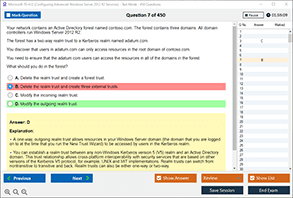
The Complete Financial Modeling and Valuation Course
Best Seller
133 Lectures
6h 33m 18s
Prepare for your Microsoft examination with our training course. The No_code course contains a complete batch of videos that will provide you with profound and thorough knowledge related to Microsoft certification exam. Pass the Microsoft No_code test with flying colors.
$13.99$24.99
Curriculum For This Course
- 1. What does the course cover? 2m 26s
- 1. Introduction to Excel - Welcome Lecture 37s
- 2. Overview of Excel 3m 39s
- 3. Basic Manipulations with Rows & Columns 1m 48s
- 4. The Excel Ribbon 2m 42s
- 5. Data Entry in Excel 3m 3s
- 6. Introduction to Formatting 5m 38s
- 7. Introduction to Excel Formulas 2m 58s
- 8. Introduction to Excel Functions 3m 47s
- 9. Cut, Copy & Paste 2m 8s
- 10. Paste Special 1m 28s
- 1. Excel Best Practices - Welcome Lecture 41s
- 2. Initial formatting of an Excel sheet in order to render it professional 1m 53s
- 3. Fast scrolling through Excel sheets 1m 29s
- 4. Introduction to fixing of cell references 2m 8s
- 5. Using the Alt plus Enter combination 38s
- 6. Learn how to organize your data with Text to Columns 1m 53s
- 7. Learn how to Use the Wrap Text Button 44s
- 8. Create easily printable documents in Excel by using Set Print Area 1m 11s
- 9. Find and select special types of cells with Select Special (F5) 1m 31s
- 10. Learn how to assign dynamic names within a Financial Model 1m 21s
- 11. Define a named range in Excel 1m 34s
- 12. Assign custom formats to specific cells within a Financial Model (ex 1m 33s
- 13. Macros are a great timesaver! Here's why! 2m 51s
- 14. Create a drop-down list by using Data Validation 1m 44s
- 15. Using Custom-sort in order to sort multiple columns within a table 1m 23s
- 16. Create a great Index page at the beginning of your models - Hyperlinks 1m 12s
- 17. Fix the top row of your table with Freeze Panes 1m 11s
- 18. Filter by color - an excellent tool 1m 44s
- 19. Working with conditional formatting 5m 40s
- 1. Keyboard Shortcuts Save LOTS of time in Excel 4m 32s
- 1. Excel's Key Functions - Welcome Lecture 45s
- 2. Key Excel Functions: Sum, Sumif and Sumifs 4m 20s
- 3. Key Excel Functions: Count, Counta, Countif, Countifs 4m
- 4. Key Excel Functions: Average and Averageif 1m 53s
- 5. Elaborate text efficiently: Left, Right, Mid, Upper, Lower,Proper, Concatenate 4m 24s
- 6. Find the minimum or maximum value in a range of cells in Excel 51s
- 7. Include Round in your Financial Models 1m 1s
- 8. Learn how to transfer data efficiently in Excel: Vlookup and Hlookup 7m 31s
- 9. Index, Match and their combination - the perfect substitute of Vlookup 7m 18s
- 10. A great Excel technique: Index, Match, Match 4m 59s
- 11. Using Excel's Iferror function to trap spreadsheet errors 1m 42s
- 12. Learn how to render your models flexible with Choose 2m 18s
- 13. Use Goal Seek in order to find the result that you are looking for 2m 13s
- 14. Include sensitivity analysis in your models through Data Tables 4m 6s
- 15. Excel's dynamic and interactive tables: Pivot tables 2m 12s
- 1. Exercise - Excel's "Sumifs" function - explained & solved 8m
- 1. Future and present values in Excel 7m 2s
- 2. Calculating the rate of return of an investment with the IRR function 3m 30s
- 3. Calculating a complete loan schedule in Excel 6m 16s
- 4. Date functions in Excel 5m 38s
- 1. Introduction to Pivot Tables & Their Application 1m 30s
- 2. Creating Pivot Tables is easy! 3m 42s
- 3. Give Your Excel Pivot Tables a Makeover 2m 9s
- 4. Modifying and Pivoting Fields In Order to Obtain the Pivot Table that You Need 4m 28s
- 5. Learn More About GetPivotData - A Very Important Excel Function 3m 40s
- 6. An Introduction to Slicers - The Moden Day Pivot Table Filters 4m 20s
- 1. Case Study - Build a P&L From Scratch - Welcome Lecture 1m 2s
- 2. Introduction to the Case Study 37s
- 3. Understand your data source before you start working on It 2m 22s
- 4. Order the source worksheets 1m 57s
- 5. Create a code: the best way to organize your data and work efficiently with It 1m 48s
- 6. Learn how to create a Database 1m 50s
- 7. Use Vlookup in order to fill the Database sheet 5m 17s
- 8. Use Sumif in order to complete the Database sheet 4m 7s
- 9. Use Index & Match as a substitute of Vlookup 3m 59s
- 10. Mapping of the rows in the Database sheet 2m 7s
- 11. Building the structure of the P&L sheet 1m 59s
- 12. Formatting sets You apart from the competition in Excel - A Practical Example 3m 15s
- 13. Populate the P&L sheet with Sumif 2m 39s
- 14. Learn how to find mistakes with Countif 2m 17s
- 15. Calculating year-on-year percentage variations the proper way 2m 59s
- 16. Create professional and good-looking charts - Introduction 20s
- 17. Build a Column Stacked Chart with a secondary line axis in Excel 5m 52s
- 18. Learn how to build effective Doughnut Charts in Excel 4m 6s
- 19. Learn how to build an Area Chart in Excel 4m 1s
- 20. Learn how to create Bridge Charts 10m 41s
- 1. Introduction to the Case Study 1m 55s
- 2. Preliminary mapping of the data extraction 2m 5s
- 3. Working with an SAP data extraction 3m 17s
- 4. Creating an output structure of the FMCG model 2m 24s
- 5. Improving the layout and appearance of the FMCG report 4m 13s
- 6. Inserting formulas and automating calculations 2m 25s
- 7. Creating a Master Pivot Table: The main data source for the FMCG report 1m 50s
- 8. GetPivotData is great! Extracting data from the Master Pivot Table 5m 40s
- 9. Combining Slicers and GetPivotData: The key to our success 3m 14s
- 10. Getting fancy with Excel slicers - Good-looking Excel slicers 3m 7s
- 11. This is how the report can be used in practice by high-level executives 3m 54s
- 1. Financial Modeling Basics - Welcome Lecture 42s
- 2. What is a Financial model? 2m 2s
- 3. Why use Financial models? 2m 35s
- 4. Financial modeling: Worst Practices - Things you should avoid 5m 49s
- 5. Financial modeling: Best practices 4m 58s
- 6. Financial modeling: The types of models that are built in practice 4m 42s
- 7. Financial modeling: The right level of detail in a model 2m 35s
- 8. Financial modeling: Forecasting guidelines 2m 51s
- 9. Building a complete model - Important considerations 2m 15s
- 10. Modeling the Income statement 5m 58s
- 11. Modeling the Balance sheet - Part 1 2m 35s
- 12. Modeling the Balance sheet - Part 2 5m 8s
- 1. Valuation Case Study - Welcome Lecture 33s
- 2. Introduction to the DCF exercise 1m 7s
- 3. The various stages of a complete DCF Valuation 6m 30s
- 4. Description of the structure of the DCF model 2m 53s
- 5. A glimpse at the company we are valuing - Cheeseco 1m 9s
- 6. Modeling the top line 3m 39s
- 7. Introducing scenarios to the model with Choose 2m 12s
- 8. Modeling other items: Other revenues and Cogs 3m 46s
- 9. Modeling other items: Operating expenses and D&A 2m 33s
- 10. Modeling other items: Interest expenses, Extraordinary items and Taxes 2m 28s
- 11. Forecasting Balance Sheet items 43s
- 12. An introduction to the "Days" methodology 1m 35s
- 13. Calculation of DSO, DPO and DOI for the historical period 1m 30s
- 14. Forecasting DSO, DPO and DOI 2m 23s
- 15. Forecasting Property, Plant & Equipment, Other assets and Other liabilities 2m 27s
- 16. Creating an output P&L sheet 2m 36s
- 17. Populating the output P&L sheet 2m 14s
- 18. Populating the output BS sheet 1m 49s
- 19. Completing the output BS sheet for the historical period 3m 41s
- 20. Creating a structure for the calculation of Unlevered Free Cash Flows 3m 5s
- 21. Bridging Unlevered Free Cash Flow to Net Cash Flow 1m 55s
- 22. Calculating Unlevered Free Cash Flow 6m 1s
- 23. Calculating Net Cash Flow 3m 56s
- 24. Obtaining the rest of the Cash Flows through Find and Replace 3m 52s
- 25. Introducing Weighted Average Cost of Capital and Perpetuity Growth 1m 56s
- 26. Discounting Unlevered Free Cash Flows in order to obtain their Present Value 2m 50s
- 27. Calculating Continuing Value and Enterprise Value of the business 2m 17s
- 28. Calculating Equity Value 1m 21s
- 29. Sensitivity analysis for WACC and perpetuity growth 4m 17s
- 30. A possible application of Goal Seek 1m 40s
- 31. Using charts in order to summarize the results of the DCF Model 4m 38s
- 32. You Made It! 2m 16s
- 33. Congratulations!! 1m 2s
Hot Exams
Isaca COBIT-2019 Exam Dumps
Microsoft PL-600 Exam Dumps
Microsoft SC-200 Exam Dumps
Microsoft MB-910 Exam Dumps
HashiCorp Terraform-Associate Exam Dumps
Test Prep LSAT-Test Exam Dumps
Microsoft AZ-204 Exam Dumps
Cisco 350-701 Exam Dumps
Cisco 350-401 Exam Dumps
Microsoft MS-900 Exam Dumps
Microsoft AZ-900 Exam Dumps
Salesforce Marketing-Cloud-Email-Specialist Exam Dumps
iSQI CTFL-AT Exam Dumps
Exin SIAMF Exam Dumps
PMI PMP Exam Dumps
ISC2 SSCP Exam Dumps
ISC2 CISSP Exam Dumps
Isaca CISA Exam Dumps
GIAC GCIH Exam Dumps
Exin EX0-105 Exam Dumps
PMI PMP Exam Dumps
Cisco 200-301 Exam Dumps
Microsoft AZ-104 Exam Dumps
Microsoft AZ-900 Exam Dumps
HashiCorp Terraform-Associate Exam Dumps
Isaca CISM Exam Dumps
Cisco 350-701 Exam Dumps
CompTIA SY0-701 Exam Dumps
Isaca CISA Exam Dumps
ISC2 CISSP Exam Dumps
ITIL ITIL-Practitioner Exam Dumps
Microsoft MS-900 Exam Dumps
Microsoft AZ-204 Exam Dumps
Test Prep LSAT-Test Exam Dumps
Microsoft SC-200 Exam Dumps
Linux Foundation CKS Exam Dumps
Isaca COBIT-2019 Exam Dumps
CompTIA CAS-004 Exam Dumps
CIPS L4M3 Exam Dumps
Microsoft PL-300 Exam Dumps
How to Open Test Engine .dumpsarena Files
Use FREE DumpsArena Test Engine player to open .dumpsarena files

Refund Policy

DumpsArena.com has a remarkable success record. We're confident of our products and provide a no hassle refund policy.

Your purchase with DumpsArena.com is safe and fast.
The DumpsArena.com website is protected by 256-bit SSL from Cloudflare, the leader in online security.
